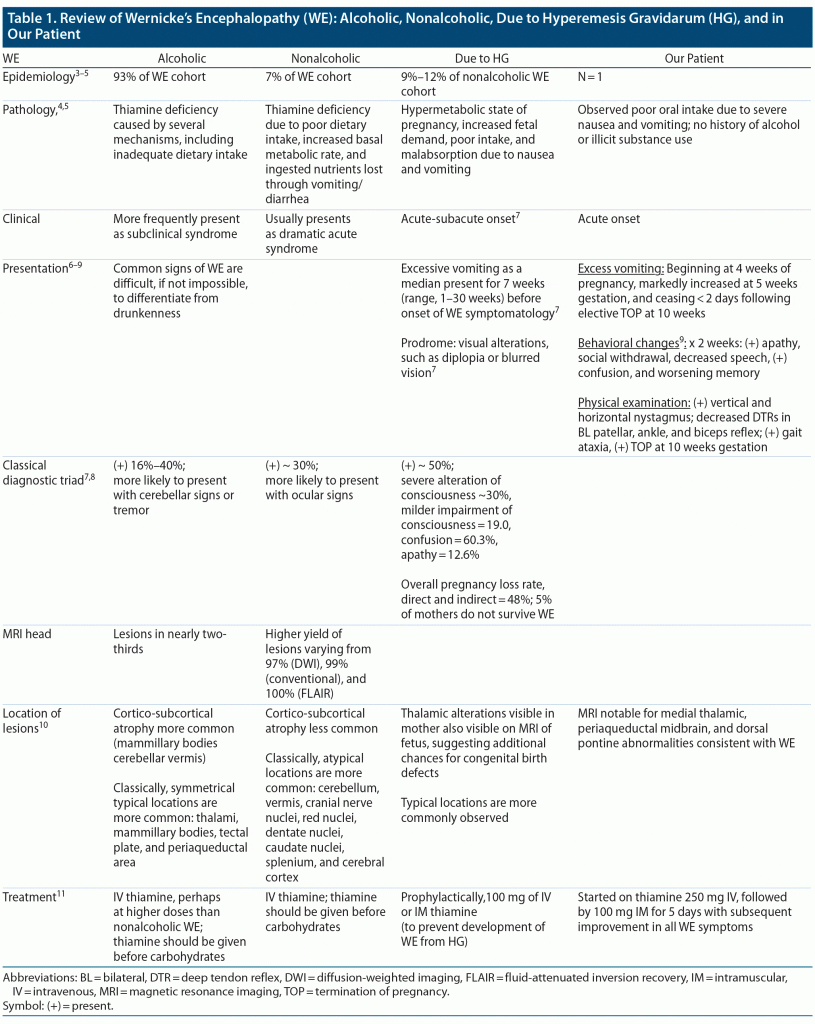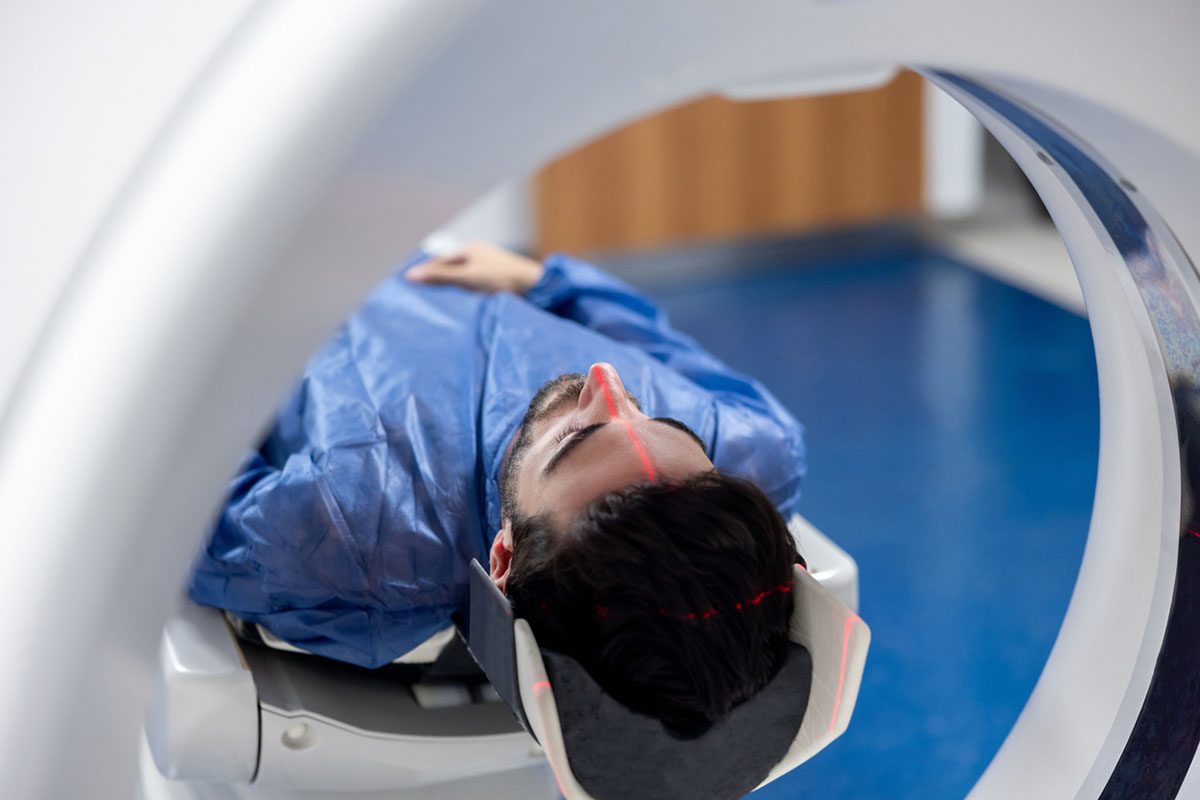
Prim Care Companion CNS Disord 2022;24(3):21cr03032
To cite: Spiegel A, Spiegel DR, McLean A, et al. Wernicke’s encephalopathy due to hyperemesis gravidarum masquerading as major depressive disorder: a reminder to assess for at-risk thiamine deficiency states. Prim Care Companion CNS Disord. 2022;24(3):21cr03032.
To share: https://doi.org/10.4088/PCC.21cr03032
© Copyright 2022 Physicians Postgraduate Press, Inc.
aDepartment of Psychiatry and Behavioral Sciences, Eastern Virginia Medical School, Norfolk, Virginia
*Corresponding author: David R. Spiegel, MD, Eastern Virginia Medical School, Department of Psychiatry and Behavior Sciences, 825 Fairfax Ave, Norfolk, VA 23507 ([email protected]).
Wernicke’s encephalopathy (WE) is an acute neurologic syndrome resulting from a deficiency in thiamine. Thiamine stores can be depleted rapidly in patients with severe hyperemesis, such as in hyperemesis gravidarum (HG).1 Early symptoms of WE are often nonspecific and can be misdiagnosed.1 We present the case of a patient, who after being diagnosed with HG and 2 weeks post–elective abortion, was admitted to the psychiatry department of our hospital and misdiagnosed with “severe depression.”
Case Report
An 18-year-old female patient with no prior psychiatric history presented to our emergency department due to behavioral changes for 2 weeks following an elective abortion at 10 weeks gestation. At presentation, the patient was inattentive and not aware of her surroundings. She was unable to provide a detailed history, but endorsed feeling “depressed and numb,” with her parents providing the remainder of the history.
Her vital signs were unremarkable, with the exception of blood pressure of 96/58 mm Hg and pulse of 104 beats/minute. There were no signs suggestive of catatonia. The complete blood count was normal except for hemoglobin/hematocrit of 9.6 g/dL/32.6%. Otherwise, complete metabolic profile, vitamin B12, folate, thyroid function tests, urinalysis, and chest x-ray were all within normal limits. Computed tomography (head) was unremarkable for acute abnormalities.
Following admission to the inpatient psychiatry department, our patient appeared drowsy with fluctuating mental status and confusion. She refused medications and meals, and staff observed episodes of emesis. At this point, despite initial impression of a severe major depressive episode, the patient was administered the Confusion Assessment Method (CAM)2 for delirium with a positive result.
On hospital day 4, she became tachycardic at 160 beats/minute, and her blood pressure decreased to 90/54 mm Hg with new leukocytosis. The physical examination was notable for lower extremity weakness with distal paresthesia and ataxia. She was transferred to the internal medicine service for further evaluation and treatment. See Table 1 for magnetic resonance imaging (MRI) head and treatment. The electroencephalogram demonstrated diffuse mild-moderate slow waves. After 5 days of treatment with thiamine, WE had markedly improved, and the CAM result was negative. Our patient was discharged on oral thiamine.
Discussion
Importantly, for a comparison and review of WE due to alcoholic, nonalcoholic, HG (WE/HG), and in our patient, see Table 1.3–11 The third most common cause of non–alcohol-induced WE is HG.3 As in our patient, recurrent vomiting during HG likely results in thiamine deficiency, more relevant during pregnancy, when thiamine requirements increase.1,10 Nonetheless, our patient is not the first reported case of WE misdiagnosed as major depressive disorder.9 Importantly, nausea, vomiting, and loss of appetite are common, nonspecific presenting symptoms of thiamine deficiency, fully overlapping with HG, with loss of appetite being common to HG/thiamine deficiency and major depressive disorder.10 Furthermore, according to a review, the spectrum of mental status changes that can occur in WE, including mental sluggishness (~20%), apathy (~10%), impaired awareness of the immediate situation, and inability to concentrate (~63%), can also be misinterpreted as major depressive disorder.7,12
Similar to our patient, the classic triad of WE (see Table 1) has been reported to occur in between 50% and 60% of WE/HG patients,7,12 with 91% demonstrating MRI alterations in the thalamic region of the brain.7 Thus, despite its non–alcohol-induced etiology, WE/HG often presents similar to alcohol-induced WE. We do caution that since a blood thiamine level was not collected prior to repletion, a deficiency was not objectively quantified. However, given MRI findings and clinical response to thiamine therapy, our patient was given a diagnosis of WE.13
WE remains a clinical diagnosis, but a nonspecific clinical presentation can lead to a delayed diagnosis. In the case of WE/HG, this delayed diagnosis can result in adverse pregnancy outcomes.14 Clinicians should consider WE in patients with unbalanced nutrition or clinical settings at risk for thiamine deficiency.11,15
Published online: May 17, 2022.
Funding/support: None.
Relevant financial relationships: Dr Spiegel is in the speaker’s bureau for Allergen, Alkermers, Otsuka, and IntraCellular but has no conflict of interest in preparation of this manuscript. Drs McLean and Monter and Mss Spiegel, Cronin, and Kamano report no conflicts of interest related to the subject of this report.
Patient consent: Consent was verbally received from the patient to publish the case report, and information has been de-identified to protect anonymity.
References (15)

- Stephens A, Patel K, Rao A, et al. Recurrent Wernicke’s encephalopathy in pregnancy: a case report. Nutr Neurosci. 2019;22(7):528–530. PubMed CrossRef
- Inouye SK, van Dyck CH, Alessi CA, et al. Clarifying confusion: the Confusion Assessment Method: a new method for detection of delirium. Ann Intern Med. 1990;113(12):941–948. PubMed CrossRef
- Galvin R, Bråthen G, Ivashynka A, et al; EFNS. EFNS guidelines for diagnosis, therapy and prevention of Wernicke encephalopathy. Eur J Neurol. 2010;17(12):1408–1418. PubMed CrossRef
- Thomson AD, Guerrini I, Marshall EJ. The evolution and treatment of Korsakoff’s syndrome: out of sight, out of mind? Neuropsychol Rev. 2012;22(2):81–92. PubMed CrossRef
- Chamorro AJ, Rosón-Hernández B, Medina-García JA, et al; Wernicke-SEMI Group; Alcohol and Alcoholism Group; Spanish Society of Internal Medicine (SEMI). Differences between alcoholic and nonalcoholic patients with Wernicke encephalopathy: a multicenter observational study. Mayo Clin Proc. 2017;92(6):899–907. PubMed CrossRef
- Žigrai M, Smetanová V, Gmitterová K, et al. Wernicke encephalopathy: a rare complication of hyperemesis gravidarum. Eur J Clin Nutr. 2020;74(4):663–665. PubMed CrossRef
- Oudman E, Wijnia JW, Oey M, et al. Wernicke’s encephalopathy in hyperemesis gravidarum: a systematic review. Eur J Obstet Gynecol Reprod Biol. 2019;236:84–93. PubMed CrossRef
- Sechi G, Serra A. Wernicke’s encephalopathy: new clinical settings and recent advances in diagnosis and management. Lancet Neurol. 2007;6(5):442–455. PubMed CrossRef
- Oudman E. Wernicke encephalopathy in patients with depression: a systematic review. Psychiatry Clin Neurosci. 2020;74(10):569–572. PubMed CrossRef
- Manzo G, De Gennaro A, Cozzolino A, et al. MR imaging findings in alcoholic and nonalcoholic acute Wernicke’s encephalopathy: a review. BioMed Res Int. 2014;2014:503596. PubMed CrossRef
- Di Gangi S, Gizzo S, Patrelli TS, et al. Wernicke’s encephalopathy complicating hyperemesis gravidarum: from the background to the present. J Matern Fetal Neonatal Med. 2012;25(8):1499–1504. PubMed CrossRef
- Chiossi G, Neri I, Cavazzuti M, et al. Hyperemesis gravidarum complicated by Wernicke encephalopathy: background, case report, and review of the literature. Obstet Gynecol Surv. 2006;61(4):255–268. PubMed CrossRef
- Chandrakumar A, Bhardwaj A, ’t Jong GW. Review of thiamine deficiency disorders: Wernicke encephalopathy and Korsakoff psychosis. J Basic Clin Physiol Pharmacol. 2018;30(2):153–162. PubMed CrossRef
- Zuccoli G, Pipitone N. Neuroimaging findings in acute Wernicke’s encephalopathy: review of the literature. AJR Am J Roentgenol. 2009;192(2):501–508. PubMed CrossRef
- Damaso ÊL, Reis ETSD, Jesus FA, et al. Wernicke Encephalopathy as a complication of hyperemesis gravidarum: case report. Rev Bras Ginecol Obstet. 2020;42(10):672–675. PubMed CrossRef
Please sign in or purchase this PDF for $40.





